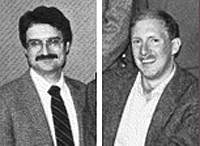Columbia Researchers to Conduct Experiment at Princeton's Fusion Reactor
 The Moment, Vol. 1, No. 3
The Moment, Vol. 1, No. 3
by Laurie Gertner
Photo: Prof. Gerald Navratil (left) and Prof. Michael Mauel (right)
In the next several months, researchers at Columbia University's Plasma Physics Laboratory will conduct experiments at Princeton University's Tokamak Fusion Test Reactor (TFTR). Last December, scientists at TFTR produced a record amount of fusion power using a new mixture of fuel. Columbia researchers will continue this work by reducing the electric current while trying to maintain the power output.
The fusion reaction occurs in a Tokamak, a device in which a plasma is confined by a magnetic field inside a hollow, donut-shaped vacuum vessel. When the plasma, a high temperature, ionized gas, is held at the required density and temperature many fusion reactions occur, each converting a small amount of plasma mass into energy. A fusion reaction in a Tokamak occurs with the nuclei of hydrogen atoms are forced to merge. The easiest reaction takes place with the rarely found isotope of hydrogen called tritium, which consists of two neutrons and one proton.
Until one month ago most of the work in fusion had been done using a fuel of deuterium, which consists of one neutron and one proton, because of the expense and radioactivity of tritium fuel. The previous experiments focused on the control of the plasma, a problem which has caused scientists to underestimate the technical problems associated with fusion power. This difficulty has caused many of the delays in plasma physics for the past 20 years.
According to Prof. Michael Mauel of the Applied Physics Department, many experiments with just deuterium had already been done. Adding tritium to the fuel was the next logical step. Before last December, the Joint European Torus (JET) had already done experiments using tritium fuel. Their work, however, which consisted of two trials of a 10% tritium fuel, was not as thorough as that at Princeton. Scientists there will continue to use tritium in proportions as great at 70% and will conduct experiments for the next year, about 1000 trials.
So far the Princeton experiments have been run in the "Supershot mode", where the current is spread out inside the Tokamak and the plasma particles are concentrated at the center. Columbia researchers will attempt the "low current regime," where the current is concentrated at the center and the particles are spread out. This technique was pioneered at the Columbia Plasma Physics Laboratory on the Morningside Heights Campus. It is advantageous to use this technique since the plasma is well confined, stable and able to run at high pressures.
According to Prof. Gerald Navratil of the Applied Physics Department, these experiments are a milestone for the field. He said, "It is exciting because after 20 years of waiting, [we are finally seeing] so much fusion power produced. It shows an overall maturity in the field. Nothing unexpected happened, but it worked."
After next year, TFTR will be shut down for decontamination. It will sit for one year and then be disassembled. In its place, Princeton physicists are hoping to build a new reactor, the Tokamak Physics Experiment (TPS). TPX will operate as a national research facility much like the national particle accelerators. Columbia's fusion research has played an important part in the design of TPX, which will use superconducting magnets to confine the plasma. In addition TPX will use a continuous operation mode instead of TFTR's pulsed operation mode. The reactor should be completed in six years.
TPX is not designed to reach "breakeven," the point at which the power input equals the power output. According to Prof. Mauel, however, the reactor at Princeton theoretically has already reached this point. That is, TFTR is too small for this to be achieved, but the technology is such that a breakeven reactor could be built on the foundation of their experiments. The goal of TPS will be to make the fusion reaction more compact and efficient rather than to reach breakeven.
Also being designed for future construction is the International Thermonuclear Experimental Reactor (ITER). This project is an equal partnership among the U.S., Europe, and Russia. Its goal is to achieve "ignition." This is when the fusing plasma reaction will continue without addition fuel.
